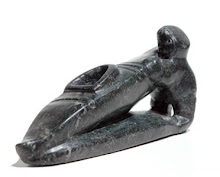This photograph (typically, a better version of it) also seems to be a frequent part of the ritual that accompanies the building of traditional qajaqs in the Western world. At times, it seems there would be a vague corpus of prescriptions that if you fail to observe your qajaq won't track true, will be slow and will leak
Edward S. Curtis recorded how in Nunivak Island, during the winter kayaks were built inside the giya, the men's house, amidst abundant ceremony. The event involved the whole community and an elaborate ritual. Participants wore specific clothes or were partially or totally naked, as required at different stages. Prescribed foods carried in particular recipients were consumed and the men whispered their secret hunting songs and sung out their childbirth songs to their new kayaks.
Sometimes, I wonder if posting pictures and keeping blogs is not what we do instead. Ways in which we keep involving a community, somewhat diffuse nowadays, in something that continues to be important for us (not to the same extent, of course. Usually, our livelihood is not linked to the qajaqs we build).

